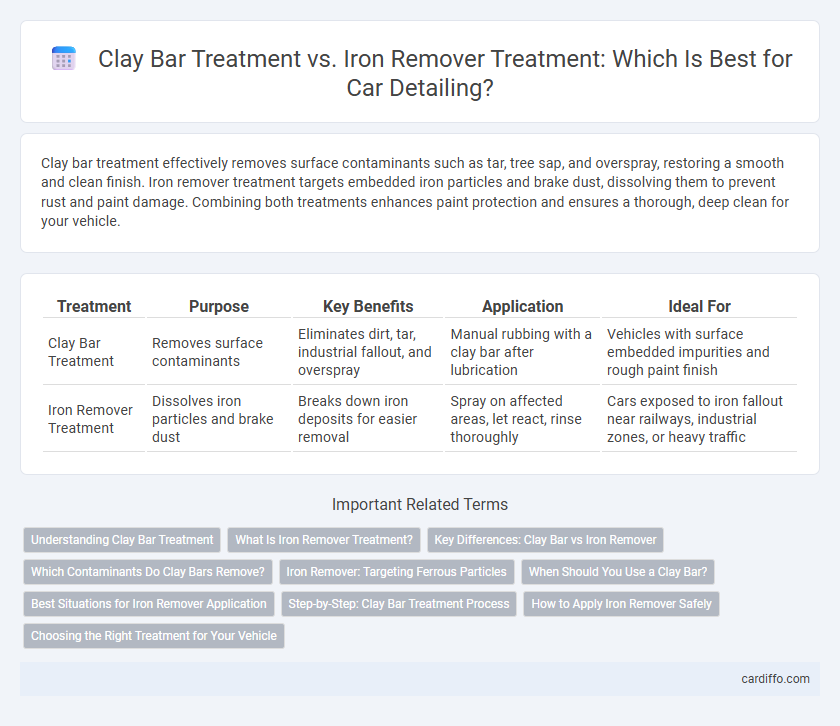Clay bar treatment effectively removes surface contaminants such as tar, tree sap, and overspray, restoring a smooth and clean finish. Iron remover treatment targets embedded iron particles and brake dust, dissolving them to prevent rust and paint damage. Combining both treatments enhances paint protection and ensures a thorough, deep clean for your vehicle.
Table of Comparison
| Treatment | Purpose | Key Benefits | Application | Ideal For |
|---|---|---|---|---|
| Clay Bar Treatment | Removes surface contaminants | Eliminates dirt, tar, industrial fallout, and overspray | Manual rubbing with a clay bar after lubrication | Vehicles with surface embedded impurities and rough paint finish |
| Iron Remover Treatment | Dissolves iron particles and brake dust | Breaks down iron deposits for easier removal | Spray on affected areas, let react, rinse thoroughly | Cars exposed to iron fallout near railways, industrial zones, or heavy traffic |
Understanding Clay Bar Treatment
Clay bar treatment involves using a specialized clay compound to gently remove surface contaminants like tar, tree sap, and industrial fallout embedded in the clear coat, enhancing paint smoothness and shine. This process is essential for preparing the vehicle's surface before polishing or waxing, as it eliminates bonded impurities that washing alone cannot remove. Unlike iron remover treatment, which targets ferrous particles and rust stains chemically, clay bar treatment physically strips off a wider range of surface contaminants, ensuring a cleaner and smoother finish.
What Is Iron Remover Treatment?
Iron Remover Treatment is a specialized automotive detailing process designed to eliminate iron particles and contaminants embedded in the paintwork, which are often invisible to the naked eye. This treatment uses chemical agents that dissolve iron oxide deposits from brake dust, rail dust, and industrial fallout without damaging the vehicle's clear coat. Unlike the physical abrasion of clay bar treatment, iron remover treatment targets microscopic iron contaminants through a reactive formula, enhancing the surface's cleanliness and preparation for waxing or sealing.
Key Differences: Clay Bar vs Iron Remover
Clay bar treatment physically removes bonded surface contaminants like tar, tree sap, and overspray, restoring a smooth paint finish, while iron remover treatment chemically dissolves embedded iron particles and brake dust that cause stubborn rust spots. Clay bars require manual rubbing and are ideal for light to moderate contamination, whereas iron removers provide deep cleaning through chemical reactions without aggressive abrasion. Choosing between them depends on the type of contaminants present; clay bars excel in general decontamination, while iron removers target iron-specific fallout for better paint protection.
Which Contaminants Do Clay Bars Remove?
Clay bar treatment effectively removes surface contaminants such as industrial fallout, brake dust, overspray, and embedded dirt that traditional washing cannot eliminate. It targets bonded particles stuck to the paint, including surface-level tar, tree sap, and pollution residues. Unlike iron remover treatments that dissolve ferrous particles, clay bars physically lift and extract a broader range of non-metallic contaminants, restoring smoothness and enhancing paint clarity.
Iron Remover: Targeting Ferrous Particles
Iron Remover treatment specifically targets ferrous particles embedded in automotive paint, effectively dissolving and removing contaminants invisible to the naked eye. This process prevents rust formation and paint corrosion by eliminating iron deposits from brake dust and industrial fallout. Unlike Clay Bar treatment, which physically lifts surface impurities, Iron Remover chemically breaks down iron contaminants, enhancing surface smoothness and paint durability.
When Should You Use a Clay Bar?
Use a clay bar treatment when your vehicle's paint surface feels rough or has stubborn contaminants like tree sap, overspray, or industrial fallout that washing alone cannot remove. Clay bars effectively lift bonded impurities embedded in the clear coat without damaging the paint, restoring a smooth finish ideal for polishing and waxing. This treatment is best performed before applying any protective sealants to ensure maximum adhesion and longevity.
Best Situations for Iron Remover Application
Iron remover treatment is best suited for eliminating embedded brake dust, rail dust, and heavy iron contaminants that clay bars cannot effectively remove. It excels on painted surfaces, wheels, and glass where iron particles have bonded through oxidation, providing a chemical breakdown rather than physical abrasion. This treatment is ideal for vehicles driven in urban or industrial areas with high iron particle pollution and after long exposure to brake dust accumulation.
Step-by-Step: Clay Bar Treatment Process
Clay bar treatment involves thoroughly washing the vehicle to remove loose dirt, followed by lubricating the surface with a detail spray to prevent scratches. The clay bar is then gently rubbed over the paint in straight motions to lift embedded contaminants such as tar, road grime, and industrial fallout. This step-by-step process results in a smooth, clean surface that improves paint clarity and prepares the vehicle for polishing or waxing.
How to Apply Iron Remover Safely
Applying iron remover safely requires wearing protective gloves and eye protection to prevent skin and eye irritation caused by the chemical agents. Spray the iron remover evenly onto a cool, shaded surface free from direct sunlight to avoid rapid evaporation and potential damage. Allow the product to dwell for the recommended time, typically 3-5 minutes, then rinse thoroughly with water, ensuring no residue remains to protect the paint finish.
Choosing the Right Treatment for Your Vehicle
Clay bar treatment effectively removes surface contaminants like tar, sap, and overspray, restoring smoothness and shine to the vehicle's paint. Iron remover treatment specifically targets embedded iron particles such as brake dust and rail dust, preventing rust and corrosion on metal surfaces. Selecting the right treatment depends on the contamination type: use a clay bar for general surface impurities and iron remover for metallic contamination to maintain optimal paint health.
Clay Bar Treatment vs Iron Remover Treatment Infographic

 cardiffo.com
cardiffo.com